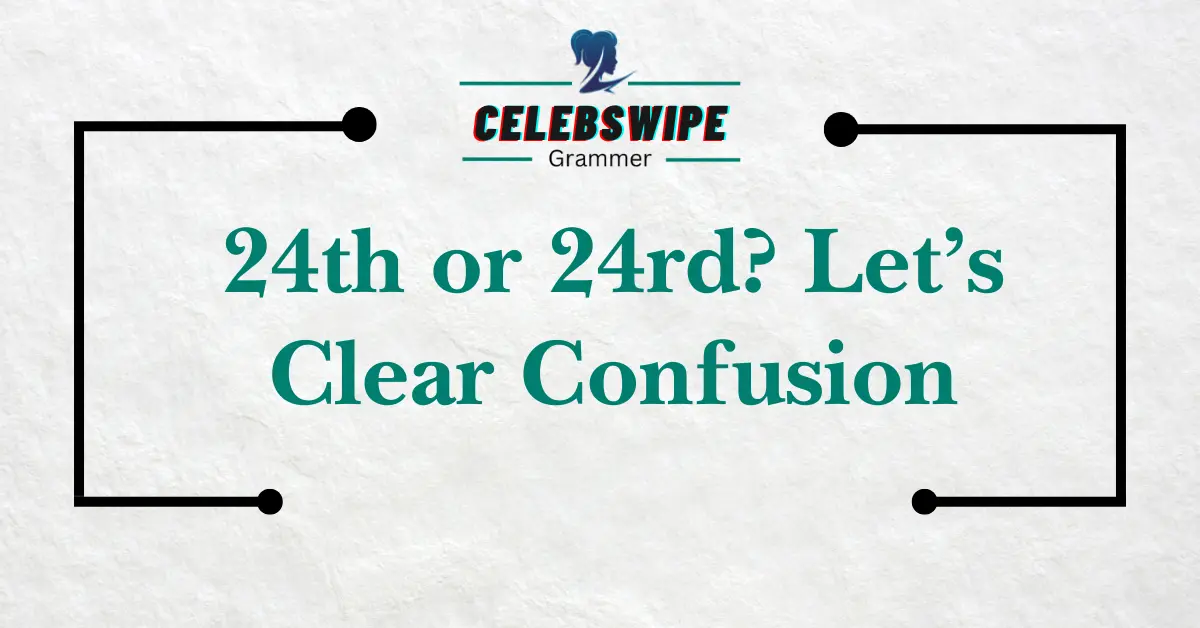Ordinal numbers can be tricky, especially when you’re unsure whether to write “24th” or “24rd.” Many people struggle with the correct usage rules for these number suffixes, leading to writing mistakes that affect usage accuracy. This article clears up the confusion by explaining the proper use of ordinal forms, diving into grammar guidelines, and offering error correction tips.
Understanding how to write ordinal numbers correctly is essential for accurate communication, whether you’re writing dates, rankings, or numerical positions. By the end of this article, you’ll master suffix rules, learn about typographical errors, and ensure your writing reflects excellence in usage.
“24th” is Correct Because Numbers Ending in 4 Use the “-th” Suffix
The correct form of the ordinal for 24 is “24th.” In English grammar, numbers ending in 4 take the -th suffix to form their ordinal. This is part of the standard language rules for ordinal endings, which apply to numbers like 14th, 34th, and 44th. Using “24rd” is a grammatical error because “rd” is only used for numbers ending in 3, such as 3rd or 23rd.
The suffix guidelines for ordinals are simple but vital to remember. When numbers like 24 are used in writing, proper use ensures accuracy. Failing to follow these grammatical rules can lead to typo errors or even confusion in digital communication, especially when auto-correct mistakes introduce unintended errors.
Understanding “24th”: The Correct Form
Writing “24th” combines the number “24” with the appropriate suffix “-th.” This follows ordinal guidelines based on the number sequence. For example, in a numerical position, 24th might indicate a rank, such as “24th place in a competition.” The right usage ensures clarity in both formal and informal contexts.
Here’s a helpful table summarizing ordinal suffixes:
| Number | Ordinal Form | Suffix Rule |
| 24 | 24th | Ends in 4 → “-th” |
| 14 | 14th | Ends in 4 → “-th” |
| 34 | 34th | Ends in 4 → “-th” |
This table highlights the correct format for numbers ending in 4, avoiding writing mistakes like “24rd” or “24st.”
Why is “24th” Correct?
The reason “24th” is correct lies in the suffix patterns of the English language. These grammatical rules ensure that ordinals follow a predictable structure. Numbers like 1, 2, and 3 are exceptions, taking -st, -nd, and -rd, respectively. However, numbers ending in 4 through 9 and 0 always use -th suffixes.
Errors like “24rd” often happen due to auto-correct issues or typing mistakes. Many spell-check tools fail to recognize ordinal methods, leading to auto-errors that disrupt proper style. Careful proofreading can prevent these text inaccuracies and maintain advanced ordinals.
Examples of “24th” in Use
Consider these examples:
- “The meeting is scheduled for March 24th.”
- “She finished 24th in the marathon.”
- “The 24th anniversary celebration was grand.”
Each example demonstrates the appropriate use of “24th” in different contexts, ensuring accurate form and avoiding typo mistakes.
Incorrect Forms: Common Mistakes with 24rd, 24st, and 24nd
24rd
“24rd” is a classic example of a typographical error. It mistakenly applies the -rd suffix, which only fits numbers ending in 3. For example, “3rd” and “23rd” are correct, but “24rd” is not.
24st
The error “24st” arises from confusing “1st” with other numbers. In ordinal categories, only numbers ending in 1 take the -st suffix. For example, “21st” is correct, but “24st” is a grammar error.
24nd
Similarly, “24nd” misuses the -nd suffix, which applies only to numbers ending in 2. Correct examples include “2nd” and “22nd.” Writing “24nd” violates the ordinal rules.
Comprehensive Overview of Ordinal Number Rules
Suffix Rules for Ordinals
| Ending Digit | Suffix | Example |
| 1 | -st | 1st |
| 2 | -nd | 2nd |
| 3 | -rd | 3rd |
| 4-9, 0 | -th | 24th |
These suffix rules ensure consistency in ordinal usage and prevent auto-correct faults.
Ordinal Numbers in Everyday Use
Ordinals appear in dates, rankings, and schedules. For example, “January 24th” or “24th on the list” reflects correct usage. Mastering these rules guarantees perfect usage in both personal and professional writing.
Practical Tips to Avoid Mistakes
To avoid writing mistakes, proofread your work carefully. Use spell-check tools but double-check for auto-correct mistakes. Understanding ordinal forms and practicing their proper use ensures your writing stays polished.
Why Accuracy in Ordinals Matters
In Professional Contexts
Using the correct form of ordinals is crucial in professional documents. Errors like “24rd” can harm your credibility and affect text accuracy.
In Digital Communication
In emails or online posts, text errors like “24nd” can confuse readers. Meticulous proofreading helps avoid such auto-errors and maintains usage accuracy.
Fun Facts About Ordinal Numbers
Did you know that the term “zeroth” is used in scientific contexts? Or that ordinal usage differs across languages? These quirks make ordinals fascinating and highlight the importance of mastering their grammatical rules.
Read More >>> Sweety vs Sweetie or Sweatie: Which One Is Correct 💕🧐
Frequently Asked Questions
Is it the 24th or 24rd?
It is 24th because numbers ending in 4 take the -th suffix according to English grammar rules.
How to write 24th in words?
You write 24th as twenty-fourth in words, following the standard ordinal number rules.
Is it 21st or 23th?
It is 21st because numbers ending in 1 use the -st suffix, while “23th” is incorrect and should be 23rd.
Is it 12th or 12nd?
It is 12th because numbers ending in 2 take the -th suffix unless they are singular, like “2nd.”
Conclusion
Understanding the difference between “24th” and “24rd” ensures appropriate use of ordinals. By following the grammar tips outlined here, you’ll avoid writing mistakes and achieve ordinal proficiency. Remember to proofread diligently and use correct usage in all your writing.

